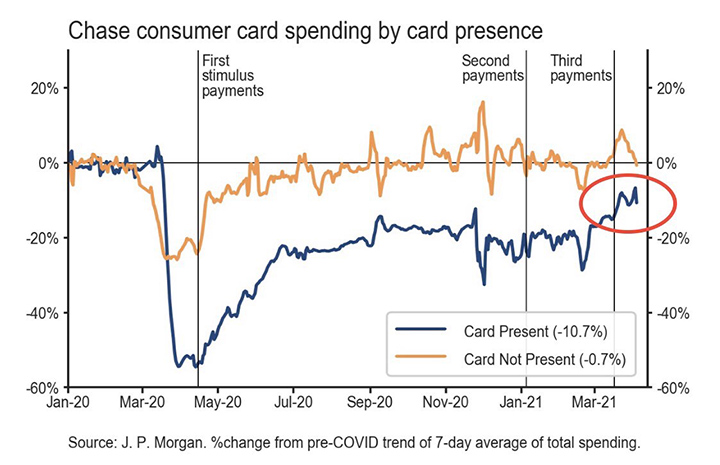The economic outlook for the second quarter of 2021 is overwhelmingly optimistic. With stimulus checks, market performance, increasing numbers of vaccinations and even the improving weather, the optimism is real! Bolstered by an unprecedented third round of stimulus payments, consumers appear to be on a spending spree. As the economy continues to reopen around the globe, spending on goods and services is ramping up. The chart below illustrates an increase in consumer usage of credit cards at a physical location. While not quite back to pre-pandemic levels, consumers are using their credit cards at the point of sale at a rapidly rising pace.

Because stocks are a leading indicator of the economy, it typically is the case that economic data lags behind market performance. Market peaks have generally proceeded recessions, and market dips generally have preceded economic recoveries. The table below shows that in the post-WWII era, there has been only one exception to a bear market starting before a recession (2000-2002). In all other cases, the bear market started before the recession, and the bear market ended before the recession ended. It has been an extraordinary run for stocks since the short-lived COVID-19 bear market ended in March 2020.

Equity market fundamentals confirm current optimism in the market. The consensus projection for S&P 500 revenue this year is a 9% increase, and earnings per share is expected to increase by 21%. With the Federal Reserve planning to keep rates low and longer-term interest rates moving up, this has led to value stocks outperforming growth stocks to start the year. The large-cap tech stocks remain near August levels, but we are seeing a broadening out of the market leaders — another positive for the stock market. The periodic table below shows the different sectors of the S&P 500 and their monthly returns over the last year. This chart makes another case for the importance of diversification in equities.

So, what can we learn from all this? Picking the right sector or the right fund is challenging in any market — but having a diversified portfolio and mix of equities provides equity exposure in good times and bad. Markets go up and down over time. The key is to stay invested and stick with the financial plan. Market downturns present opportunities to purchase stocks that were previously viewed as overvalued. In a down market, you are “buying low,” one of the fundamental tenets of investing.
Given the difficulty of timing the market, the most realistic strategy for a majority of investors is to invest and stay invested over time. Procrastination, or not investing, is worse than bad timing. We continue to view more risk being out of the market than in the market. Riding out future market volatility, in addition to having a diversified portfolio, means staying the course. From an investment perspective, we use trends to help with the strategic and tactical asset allocation and where we see the portfolio heading over the next 5-7 years with short-term adjustments along the way.
It all starts with a solid financial plan for the long run that understands the level of risk that is acceptable for each client. With regards to investments, we believe in diversification and having different asset classes that allow you to stay invested. The best option is to stick with a broadly diversified portfolio that can help you to achieve your own specific financial goals — regardless of market volatility. Long-term fundamentals are what matter.
Sources: JPMorgan, Bloomberg, Schwab
This material contains an assessment of the market and economic environment at a specific point in time and is not intended to be a forecast of future events, or a guarantee of future results. Forward-looking statements are subject to certain risks and uncertainties. Actual results, performance, or achievements may differ materially from those expressed or implied. Information is based on data gathered from what we believe are reliable sources.
Using diversification as part of your investment strategy neither assures nor guarantees better performance and cannot protect against loss of principal due to changing market conditions.
Past performance is not a guarantee of future results.
The opinions expressed in this commentary are those of the author and may not necessarily reflect those held by Kestra Investment Services, LLC or Kestra Advisory Services, LLC. This is for general information only and is not intended to provide specific investment advice or recommendations for any individual. It is suggested that you consult your financial professional, attorney, or tax advisor with regard to your individual situation.
Securities offered through Kestra Investment Services, LLC (Kestra IS), member FINRA/SIPC. Investment Advisory Services offered through Kestra Advisory Services, LLC (Kestra AS) an affiliate of Kestra IS. Kestra IS and Kestra AS are not affiliated with CD Wealth Management. Investor Disclosures: https://bit.ly/KF-Disclosures





